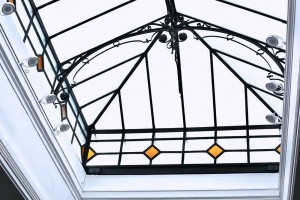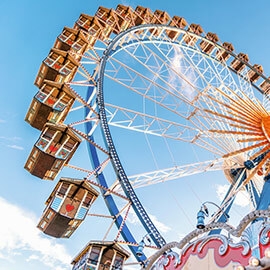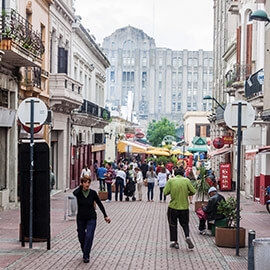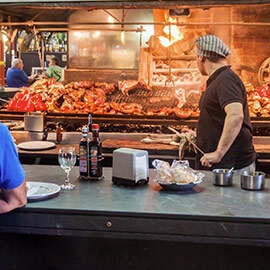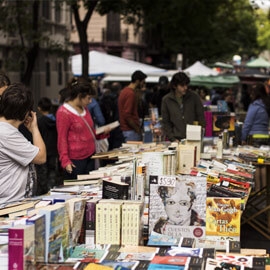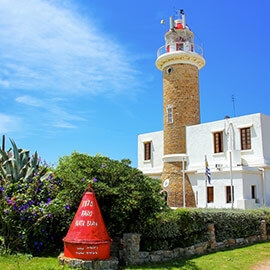enforex_pages_dest_expl_block_96466f46-6c3d-4227-8117-944aa09314e0
The capital of Uruguay is one of the safest and most advanced cities in Latin America. Come to learn Spanish in Montevideo and discover all this great city has to offer: from its modern skyscrapers to colonial-style architecture, so present in the Old City. Montevideo will surprise you with its contagious rhythm, vibrant markets, traveling fairs and delicious gastronomy. Savor a typical chivito while chatting with the friendly locals, or feel the Uruguayan passion for soccer while socializing with the fans of this fascinating sport. From the elegant streets between colonial buildings and art deco facades, to the charm and bustle of the Mercado del Puerto, Montevideo is a city to enjoy.
QUICK FACTS ABOUT MONTEVIDEOenforex_pages_des_engage_block_185bd003-9c13-4367-ac2f-277137ae6831
The school organizes a wide variety of activities, workshops and excursions for you to engage the Uruguayan culture after your Spanish classes in Montevideo. Sign up for the international exchanges with native Spanish speakers, you will share experiences and traditions while improving fluency. Or take part in the educational activities (film, music, literature, cooking, etc.) to get involved in the most social and humanistic aspects of the Spanish language.
Finally, travel through Montevideo with us thanks to our amazing excursions: walks through the main neighborhoods; visits to museums, wineries and main tourist attractions; tours of the city's historic bars and restaurants, which were a meeting point for renowned artists and writers; nice bike rides to tour the Rambla of Montevideo to enjoy beaches and beautiful views... All this and much more for you to have the best learning experience!
#donQuijoteMontevideoenforex_pages_dest_learn_block_f89041c4-ba4d-4f80-98e2-450c7b914263
Our partner school has the best variety of Spanish courses in Montevideo. In addition, our team is made up of expert professionals with extensive experience and training. Our courses are taught in a personalized way, so you decide how many hours to invest in classroom learning. Choose our Intensive 20 if you want to have some free time to enjoy after lessons; or the Super Intensive 30 if you want to make the most of your time studying. You can also add private classes if you need to reinforce specific contents; or take the opportunity to obtain an official certificate through our DELE Exam Preparation Course. But if what you want is to live a complete immersion in the local culture while acquiring fluency, we recommend the blended program, which combines 20 sessions of Spanish with 3 of milonga.
QUICK FACTS ABOUT OUR SCHOOLSpanish schools in Montevideo - Spanish language courses
Our Partner School in Montevideo
Our Spanish school in Montevideo is in the Old City, very close to the Plaza de la Independencia Square, the Port, and the main museums and attractions of the city. In addition, it is an area offering all the services needed for a comfortable stay. The school, founded in 2007, is located in an impressive colonial building in Plaza Matriz just a 5-minute walk to the beach. It has bright classrooms with high ceilings and modern amenities and areas.
- Modern, fully equipped classrooms
- Located in the city center
- 5-min. walk to the beach
- Cafés, restaurants, and shops nearby
- Public transportation at the door
Learn Spanish
Our partner school has the best variety of Spanish courses in Montevideo. In addition, our team is made up of expert professionals with extensive experience and training. Our courses are taught in a personalized way, so you decide how many hours to invest in classroom learning. Choose our Intensive 20 if you want to have some free time to enjoy after lessons; or the Super Intensive 30 if you want to make the most of your time studying. You can also add private classes if you need to reinforce specific contents; or take the opportunity to obtain an official certificate through our DELE Exam Preparation Course. But if what you want is to live a complete immersion in the local culture while acquiring fluency, we recommend the blended program, which combines 20 sessions of Spanish with 3 of milonga.
Discover our Spanish Courses
QUICK FACTS ABOUT OUR SCHOOL
Travel Through Montevideo
The school organizes a wide variety of activities, workshops and excursions for you to engage the Uruguayan culture after your Spanish classes in Montevideo. Sign up for the international exchanges with native Spanish speakers, you will share experiences and traditions while improving fluency. Or take part in the educational activities (film, music, literature, cooking, etc.) to get involved in the most social and humanistic aspects of the Spanish language.
Finally, travel through Montevideo with us thanks to our amazing excursions: walks through the main neighborhoods; visits to museums, wineries and main tourist attractions; tours of the city's historic bars and restaurants, which were a meeting point for renowned artists and writers; nice bike rides to tour the Rambla of Montevideo to enjoy beaches and beautiful views... All this and much more for you to have the best learning experience!
The largest green space in the city has a lake and expansive fields perfect for playing sports, resting in the shade or having a picnic.
This extensive avenue defines the Old City and is a hotbed of shops, restaurants and bars in which to enjoy good times getting to know the local culture.
This market dates to the 19th century, but is still one of the best places in the city to observe the local way of life and savor a tasty barbecue.
The most popular and touristic flea market in Montevideo. Get antiques and souvenirs while practicing your Spanish with the shopkeepers.
Located on the 30-kilometer-long Montevideo promenade, ideal for a bike ride, this lighthouse is a beautiful spot to watch the sunset over the Río de la Plata.
 Hop from city to city
Hop from city to city
Would you like to learn Spanish in multiple destinations?
Contact us, we are happy to help!
Tell us where you want to goDiscover Montevideo
The capital of Uruguay is one of the safest and most advanced cities in Latin America. Come to learn Spanish in Montevideo and discover all this great city has to offer: from its modern skyscrapers to colonial-style architecture, so present in the Old City. Montevideo will surprise you with its contagious rhythm, vibrant markets, traveling fairs and delicious gastronomy. Savor a typical chivito while chatting with the friendly locals, or feel the Uruguayan passion for soccer while socializing with the fans of this fascinating sport. From the elegant streets between colonial buildings and art deco facades, to the charm and bustle of the Mercado del Puerto, Montevideo is a city to enjoy.
AFRICAN CARNIVAL - December to February
Festive parades and marches, thousands of unique costumes and rhythmic music.
LEMANJÁ - February 2
Tribute to nature at the beach. Colors, food, and chanting by candlelight.
NOSTALGIA NIGHT - August 24
The city holds more than 300 fiestas to remember great music hits from the past.






